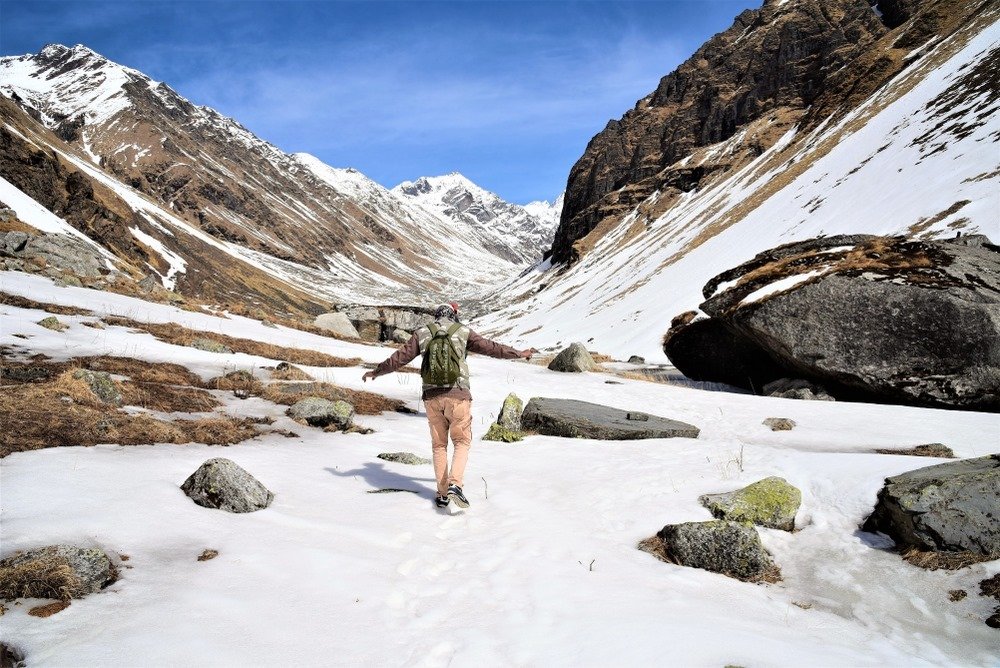I recently completed the Har Ki Dun trek, and if you’re wondering whether it’s tough or manageable, I’ve got you covered—with no fluff, just the reality of what to expect.
The Real Deal: Difficulty Level of Har Ki Dun Trek
Let’s cut straight to it. On a scale of 1 to 10, with 10 being a grueling expedition like Everest Base Camp, I’d rate Har Ki Dun around a 5.5 to 6. It’s definitely not a cakewalk, but it’s far from extreme. If you have average fitness, a bit of mental prep, and the right pace, you’ll do just fine.
This trek sits comfortably in the moderate category. It’s not technical—no climbing gear, ropes, or mountaineering knowledge needed. The terrain isn’t dangerous, and most paths are well-marked, although some sections do get a bit tricky with melting snow or slush depending on the season.
Altitude: Not Too High, But You’ll Feel It
Har Ki Dun sits at 11,700 feet (3,566 meters). That’s not Himalayan high, but altitude sickness can still sneak up on you if you’re careless. On the third or fourth day, most of us noticed a slight dip in energy, heavier breathing, and mild headaches—but nothing that a slower pace and hydration couldn’t handle.
One of the great things about this trek is that the ascent is gradual. There’s no sudden jump in elevation, which gives your body time to adjust. We had a solid itinerary with well-timed breaks, which I’ll talk about later.
Trail Conditions: Mud, Rocks, and Beauty
What surprised me most? How varied the trail is. You walk through ancient villages, pine forests, icy bridges, river crossings, and snow patches, all within a week.
-
First couple of days: Dirt paths, minor climbs, relatively easy.
-
Middle stretch: More inclined, with boulders and muddy trails.
-
Final day towards Har Ki Dun valley: Some snow in early summer or post-winter, and a fair bit of uphill.
It does get slippery in pre-monsoon and early winter. One of our team members slipped on a snowy patch near Kalkatiyadhar, but with good trekking shoes and a walking stick, you’re golden.
Fitness: Do You Need to Be an Athlete? Nope.
Here’s the truth: you don’t need to be an ultra-marathon runner, but being a couch potato won’t cut it either. I had done a few weekend hikes and basic cardio before signing up. If you can brisk-walk for 30–45 minutes daily for a month before the trek, you’ll survive—and actually enjoy it.
Key muscle groups—your legs, back, and lungs—will get the most action. I saw people in their 50s complete it comfortably, while some younger trekkers struggled because they underestimated it.
The Mental Side: More Important Than Physical
There’s a point on the trail—usually around day 4—where most people hit a wall. The novelty wears off, your legs hurt, and the air feels thinner. That’s when your mind takes over.
Having a guide who knows the terrain, the weather patterns, and can motivate you with stories or history makes a huge difference. We went with a local team via The Searching Souls for har ki dun trek, and honestly, their experience kept the group moving when spirits were dipping. They weren’t overbearing or pushing promotions, just genuinely helpful locals who’ve done this a hundred times over.
They paced the group well, handled the campsite logistics smoothly, and even spotted a Himalayan Monal for us!
Weather: Unpredictable, So Be Ready
We trekked in May. Mornings were warm, afternoons brought clouds, and by late evening, temperatures dropped fast. Nights at campsites like Boslo and Kalkatiyadhar were chilly—hovering around 0°C to 2°C.
If you trek in early spring or post-monsoon, be prepared for snow patches and slushy trails. Rain is common during the monsoon, and that can make paths trickier and increase the risk of leeches.
What helped me? Layers. Thermals, fleece, a waterproof jacket, and extra socks. Trust me, staying dry and warm is half the battle won.
Food and Stay: Basic but Satisfying
Don’t expect hotel comforts, but honestly, the food was good—simple, hot, and fresh. Dal-rice, sabzi, chapati, and sometimes a dessert like halwa. After 5–6 hours of trekking, even a basic meal feels gourmet.
Tents were clean, sleeping bags warm, and the guides from The Searching Souls made sure campsites were well set up by the time we arrived. At Seema and Osla villages, you get to see and sometimes stay in wooden homestays, which adds a beautiful cultural flavor.
Biggest Challenges I Faced
-
River Crossings: Water was ice-cold and swift. You’ll need to cross barefoot sometimes, holding hands with others for support.
-
Altitude Fatigue: Day 3 and 4 were the toughest. But lots of water, ORS, and short breaks helped.
-
Limited Network: There’s zero phone signal after a point. And weirdly, that’s kind of freeing—but make sure people at home know in advance.
Why I’d Still Do It Again
Surrounded by snow-capped peaks, old pine trees, and a river winding through the meadows, the valley of Har Ki Dun is a bizarre place. There’s an energy there, a kind of peace that makes every ache worth it.
Plus, I met people from all walks of life—some first-timers, some experienced trekkers—and we bonded over chai and stories. That human connection, away from screens and noise, is rare.
So, Is Har Ki Dun Trek Difficult? Final Word
In plain speak? It’s moderately difficult, very doable, and extremely rewarding. If you’re reasonably fit, mentally ready, and have a solid guide like the folks from The Searching Souls, you’ll not only complete it—you’ll love it.
Be mindful of your body, respect the mountains, and prepare thoroughly. That’s it.





